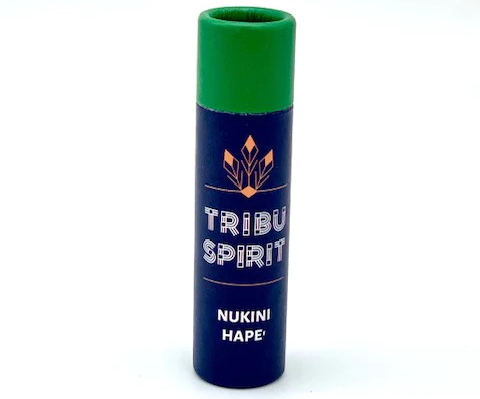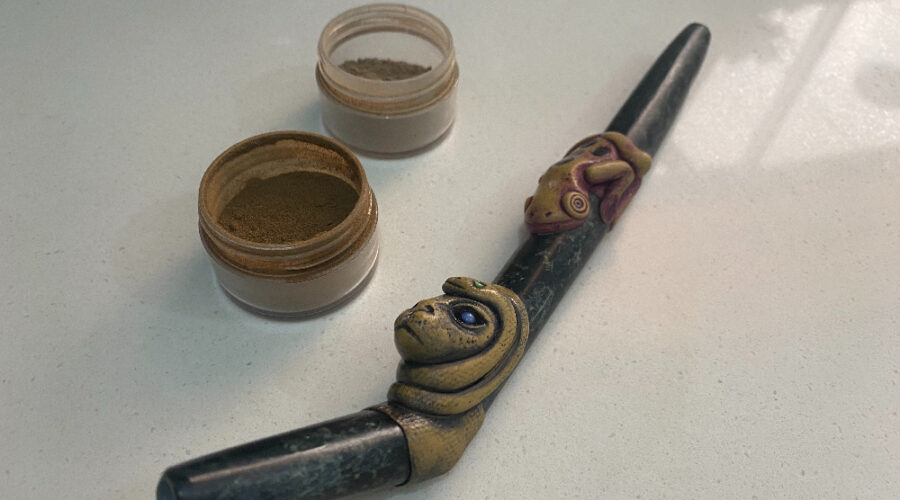Here’s Why Hapé Tobacco is Shunned by Westerners, But Loved By Shamans
Tobacco has a reputation as a poisonous substance in Western culture. But for many cultures, it is a very sacred and powerful plant medicine. One way that tobacco is used for healing and insight by native tribes in the Amazon is in the form of snuff, called hapé tobacco (pronounced ha-peh, and also known as rapé or rapeh).
Indigenous communities across the Amazon–many of the same groups that use ayahuasca–use hapé to support physical healing, spiritual connection, and energetic cleansing. While once used only by the elders, or shamans, in a community, hapé has now expanded beyond the borders of the jungle and has a firm place in the medicine bag of many non-indigenous folks.
So, what exactly is hapé? And what does it do?
RELATED: Find Ayahuasca Retreats Around the Globe
What is Hapé Tobacco (aka Rapé?)
Hapé is a sacred snuff, usually made up of a mix of sacred jungle tobacco (mapacho) and other medicinal plants that come from the Amazon. It is primarily used by the native tribes of Brazil and Peru. But its use has spread into other South American ceremonial contexts, including in Colombia.
“Hapé is actually a name that was given by colonization,” says Zeque Amrita, a student of ancestral traditions and sacred medicine facilitator from Brazil. “Its original name is ‘rume,’ which means tobacco. Its name is ‘rume reshke’ in Huni Kuin culture and ‘rume poto’ in the Yawanawá culture,” he explains.
“Traditionally, the healers and the elders used hapé to heal and cleanse. Today, we [non-indigenous people] use hapé. It’s a masculine medicine, that helps us do the right thing and make good decisions, like a father or grandfather,” explains Amrita.
“Today, hapé helps us in many areas. It helps us heal in relation to our thoughts, emotions, and spirit. We can also use it to pray because when we have hapé in our bodies we’re connecting with ancient spirits and ancestors. It helps strengthen our prayer, our mind, and our spirit.”
RELATED: Five Healing Products to Support Your Plant Medicine Journey
Hapé Brings Many Benefits
When used consciously and responsibly, hapé provides a myriad of benefits for our physical, emotional, and spiritual health. I have personally found hapé to be incredibly powerful in helping me feel grounded and connected to nature. As well as gain clarity around certain situations in my life.
“Hapé brings a deep relaxation into the body, helping us to relieve a lot of tensions in the neck and shoulder area,” says Emmy Morris, a medicine woman who was initiated into the hapé tradition by the Brazilian Huni Kuin tribe.
“One thing that hapé does beautifully is it bring us into the present moment and into our body. It clears our auric field, so this is why it can be used when you’ve had a tough day and you need to shake off all of the energy.”
RELATED: Where Is Ayahuasca Legal In 2023: A Growing List
Contrary to popular belief, tobacco – when used as medicine – can be effective in opening up and healing our respiratory tracts. “Another thing it helps with is clearing out the mucus and accumulated bacteria we have in our nose. It can also help people who have chronic sinus problems when used in the right way,” says Morris.
“And when hapé is really strong it can make us vomit, and through the vomit, we’re clearing out so many stagnant things that are physically and energetically stuck in our body,”
Many indigenous cultures view tobacco as a medicine that connects you to your heart and your emotions, which is often felt after taking hapé. “Hapé is incredible for opening your heart. When you have hapé and you sit down and meditate with it, you can feel your heart expanding,” says Morris.
RELATED: Modernized vs. Traditional Ayahuasca Ceremonies: Which is Right For You?
How to Use Hapé Tobacco
In order to use hapé tobacco, you will either serve yourself using a self-applicator called a kuripe, or receive the medicine from somebody else, who applies it to you using a tepi.
For instructions on how to self-administer hapé, check out this helpful guide. If you’re receiving hapé from someone else, make sure it’s someone who knows the medicine well. “If the person that’s serving you doesn’t exactly know what they’re doing, this could be dangerous for your energetic field,” says Morris.
This sentiment was echoed by Amrita, the Brazilian medicine facilitator. “If you’re going to receive a soplo (blow) from someone, it’s very important to know who is giving it to you. There are a lot of people that serve hapé but they don’t know what they’re doing.”
When using hapé outside of a ceremonial context, or on your own, it’s important to remain mindful and conscious of why you’re using it in that moment. As with all sacred medicines, having an intention is paramount to gain the benefits and not slip into mindless use – which can be easy with hapé.
Morris recommends creating a ritual around your hapé use and creating the right setting for it. “For example, if you’ve had a rough day and you need to let go of a lot of energy, set an intention. Allow the medicine to clear out your energy and release everything from the day. So really setting a little ceremonial space to receive hapé for yourself.”
It’s advisable to only do hapé when you feel a calling to work with the medicine, and a maximum of once every other day, says Morris.
Four Types of Hapé Tobacco For Your Personal Use

Apurinã Awiry
New to the medicine? Apurinã Awiry is an excellent hapé for those who are seeking a lighter experience to start with. This hapé contains either very little or no tobacco at all, and “works in a very delicate way” according to Morris.
“It’s a very feminine hapé, and brings a lot of peace to the body,” she says.
Check out this Apurinã Awiry hapé from Sacred Blend.

Tsunu
For something slightly stronger, Morris recommends Tsunu hapé. “It has quite a lot of strength but it’s in a gentle way, because it’s a very fine hapé so it goes exactly where it needs to and brings a lot of calmness to the body,” she says.
Tsunu hapé comes from the Yawanawá tribe, and is a mix of tobacco and Tsunu bark ash.
Check out this Tsunu hapé from Queen of the Forest.

Nukini
Looking for something a little strong? Then Nukini hapé is a good choice. “Depending on how it’s served, Nukini can be very grounding and also has the property of being able to make you purge. It helps to release and clean a lot,” explains Morris.
Take a look at this Nukini clarity hapé from Tribu Spirit.

Paricá
Made by the Brazilian Katukina tribe, Paricá hapé, is considered a strong hapé that’s traditionally used in ceremonial contexts. This hapé is made using the bark of the seed used in Yopo. Making it great for deeper meditation and centering.
Check out this Paricá hapé from Spirit Visions.
Whichever hapé you choose, it’s vital to remember to use it consciously and with intention. Hapé has the power to induce states of clarity, calm, and connection. But like all sacred medicines, must be used responsibly in order to achieve this.



